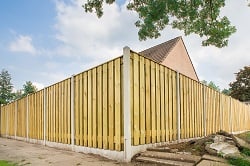
The strength of a fence comes from the corners. Fences with sturdy, well-crafted corner posts are more likely to stand the test of time. Meanwhile, shabby corner posts might fall from a gust of wind or a small bump. Corners hold the most amount of tension within a fence, and a strong corner will anchor the fence to prevent tension from letting up. So, what makes a corner sturdy and strong? The materials and techniques used to build it, which will depend upon its intended purpose. For example, a fence for livestock would differ from a fence for the garden. Other factors, such as soil type, will play a role in determining required materials as well. Here are 6 elements to consider when building a strong fence post.
Post Type
Fence posts are typically made from pressure treated wood. The specific type of wood used will depend on the soil and weather conditions in the location the fence is being built. A fence post in the Northwest might use woods like pine or Douglas fir, meanwhile those in the Northeast might choose composite wood to prevent against degradation from insects and rot.
Post Length
The average passerby might underestimate the actual length of a fence post. Standard posts are about 8 feet tall, and 24 to 30 inches are buried beneath the ground to provide solid support. In areas with loose, sandy soil, a longer post might be required so more of the post can rest underground to provide the required amount of stability.
Post Diameter
A sturdy fence corner will also need to have a diameter of at least 5 to 6 inches in order to hold up against tension once the fencing is applied. The diameter of a corner post contributes to the stability of the fence and helps keep the fence tight after years of use.
Strainers
While a strainer is not a necessary component of a fence corner, it helps alleviate tension at the weakest part of the post. An in-line strainer transfers tension from the top of the corner post (the weakest point) to the base of the post (the strongest point). Strainers also help keep the fence square as tension will be lower, thus reducing the possibility of leaning.
Braces
Braces are another element that contribute to the stability of a fence. These horizontal posts connect to the corner posts and are often called “H” braces. They should be placed about 1 foot below the top of the vertical posts and are slightly smaller than upright posts. Braces are usually about 4 to 5 inches in diameter and 8 feet long.
With these 6 elements in place, you should be well on your way to building a sturdy fence with strong and stable corners. While the goal is to build a sturdy, long lasting fence, efficiency is also a consideration. It can be time consuming to fasten fence staples the old fashion way, but with the Gas Fence Stapler, offered by BECK America, efficiency doesn’t compromise quality. This high-powered tool is perfect for hardwood applications, and its nose and depth of drive are specifically designed for wire fencing. Click below for more information on the Gas Fence Stapler.
.svg.png)

